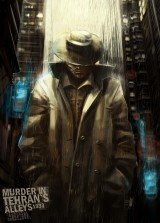Review for Maquette
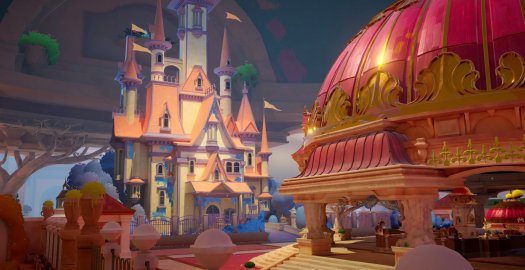
Love can be many things, but the basis for a first-person recursive puzzle game is a new one. Yet that's how Maquette, from developers Graceful Decay, plays out. Like a more romantically focused Superliminal, you must overcome physical obstacles by manipulating model-sized components to affect their life-sized counterparts in beautiful 3D settings whilst also changing your own perspective of your shifting relationship. When the puzzles work, the world-within-a-world is a joy to explore and play with. Unfortunately, there are too many puzzles that have too little explanation as to how they’re supposed to work, which starts to confuse matters. This, along with having to follow an overly annoying couple's story, left me feeling ready to break up and move on by the end.
It's a simple tale we can probably all relate to: boy meets girl, boy and girl fall in love with each other, then ... things slowly start to fall apart. You’ll probably recognise at least one of these voices. This story's “girl,” Kenzie, is performed by Bryce Dallas Howard of Jurassic World fame, whilst her real-life husband Seth Gabel plays the “boy,” Michael. They are both unsurprisingly brilliant in their roles, even if those roles are to play a saccharine-sweet cutesy couple that is sure to make anyone who’s been even slightly in love grimace.
The game starts in a sprawling botanical garden at night, as scripted lines of Michael’s thoughts appear against the lovely background scenery as he recalls finding the old sketchbook he and Kenzie once shared back when they were together (just a little hint that things might not end up so well). When the book is opened at the end of this scene, the action shifts to the first hub-like world and the tale goes back to the beginning of Kenzie and Michael's relationship, when they've just met each other.
We never see the characters on-screen, just hear their voices, listening in on choice moments of their past together. As you continue to move through the world, more handwritten lines from their book scribble across the screen, filling us in on the couple's thoughts about mundane things like what they did for lunch that day to slightly more emotional topics like whether they're really meant to be together. Occasionally a partially animated cutscene of sketches will appear, offering a more tangible illustration of small but memorable events they’ve shared.
The game is divided into seven chapters, and each one puts you in a slightly different metaphorical space representing a stage in our lovers' relationship. Normally they’re centred around a brightly coloured Disney-esque dome, which slowly starts to crack and become less vivid as time wears on. For example, one of the areas around the dome is a fun fair the lovers went to on one of their early dates, whilst another is a house party where the couple got to meet some of each other’s friends. Later on, when things aren't quite going as well, a visually outstanding section sees you walking through monochrome streets, with lights in buildings turning off one by one.
There’s no doubting this game is gorgeous to look at. Every location is packed full of vibrant colours (at least until the relationship starts to fall apart, when things turn duller) with brightly hued flags swaying in the breeze on top of majestic castle-like structures, and ornate bridges standing alongside tall golden-topped gateways and fences. It captures all the classic fairy-tale depictions of romance and “meeting one’s prince or princess” perfectly. Unfortunately, there isn’t much narrative detail factored into the worlds you explore; aside from the objects you need to pick up to progress, there’s not much to interact with and certainly very little environmental storytelling going on. The aforementioned fun fair, for example, could have had games for players to actually play – instead it’s mostly just a group of closed-off tents with one or two sad-looking carnival objects (balls, a teddy bear) sitting around to give you the gist of what’s going on.
Of course, there’s a reason why interaction had to remain limited. The world of Maquette is recursive, which means that most chapters have two versions of the same environment: a smaller-scale iteration within the dome, surrounded by a larger carbon copy outside of it. Every action that takes place in the little one is mirrored in the bigger one. So drop a miniature cube to form a bridge in the model world, and a giant cube will do the same in the full-sized world, giving you access to a new area and therefore unlocking the next part of the story. The opposite will happen if you drop the cube into the larger area too. Objects can be shrunk or made bigger by being taken out of one location and dropped into another several times, which adds to the puzzle aspect – e.g. a key you might find to unlock a door in the large world might be too small, so you'll have to drop it in one area enough times to make it big enough to use.
The only objective for each chapter is to simply make your way to the next. To do this you move about in first person via WASD or controller, panning the camera freely about you with the mouse or analog stick, and can pick up and carry one item in front of you with either scheme’s respective action button. You can then toggle between holding out that object to use it and dropping it into place, sometimes rotating it first for the desired orientation. What sounds like a fairly simple set of controls somehow feels quite tricky and clunky when put into practice – there were quite a few times where I had to move myself to a specific angle to pick something up, as the input wasn't recognised, which got a little frustrating particularly in later challenges when manoeuvring crystals into small spaces.
Once or twice I also found myself stuck between ledges or unable to pick up an object that had gotten stuck, but mercifully I wasn't too far from the beginning of the chapter, which is where you'll have to manually reload to start again if something like that happens, losing any progress you’ve made. In comparison to the picturesque world around you, your actions therefore sometimes feel a little ungainly, and whilst most of the time it doesn’t cause too much of an issue, it can make the delicate puzzles in the game that extra bit more troublesome.
A lot of the early obstacles are based around environmental platforming – finding ways to reach areas that are otherwise inaccessible by making objects smaller or larger. But in later sections you’ll encounter puzzles with other types of goals. One big chapter has you working out how to move various coloured crystals into equivalently coloured holes around different parts of the map. Whilst still using the same mechanics of making things smaller and bigger, there’s no explanation of how the crystals work with scattered coloured gateways – it’s not at all clear that suddenly by holding a crystal you can enter an otherwise blocked off area of the map, until you accidentally do so. Whilst it's definitely good to see puzzles evolving for variety, the abrupt change in style without any instructions left me wandering around for some time before realising what I was supposed to be doing. This happened a couple of times throughout the game. Although I like a challenge and figuring things out for myself, a clearer prompt – even if just a small one – to indicate that new rules had been introduced would definitely have been appreciated.
Alongside the strong voice acting, Maquette is peppered with tracks sung by local artists as well as original compositions from audio director Cody Predum. The songs, which mostly head up each chapter, would not be out of place in any indie romance film and mostly fit well with the game’s themes, except for one tune whose bombastic tones seemed glaringly at odds with that chapter's chilled atmosphere. In general, the music and light use of sound effects (a bird tweeting, footstep noises) contribute positively to a consistently slick production.
The story itself is a little predictable, especially as it's obvious from the beginning that this relationship is doomed to fail. Despite Howard and Gabel's efforts, both Kenzie and Michael really are quite unlikeable as a couple and simply as people – though it could well be the game's intention for that to be so, and for the player to realise just as the characters do that they're better off with different people. Even if that is the case, it does mean it's hard sometimes to want to persevere and see the full story out.
The game took me eight hours to complete, and whilst there was enough diversity in the puzzles and locations to keep me playing, the obvious narrative development and bothersome characters gave very little incentive to continue beyond that. Add to that the periodic lack of direction about the game’s changing requirements and the experience ended up feeling rather long. Like one too many real-life dating situations, Maquette seems to tick all the right boxes at first with its intriguing concept and brightly coloured locations. But look a little deeper and its flaws are clearly there, making it a fun if forgettable fling but perhaps not marriage material.






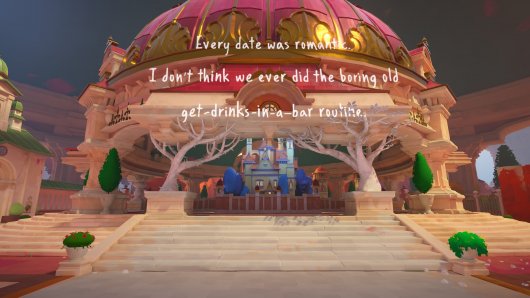




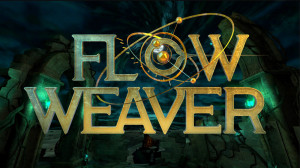

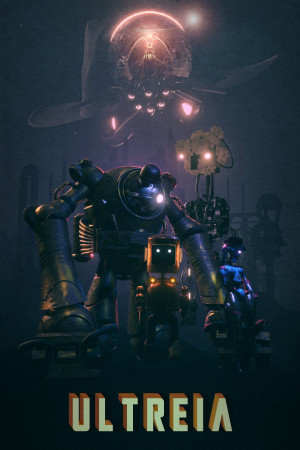

__medium.jpg)





